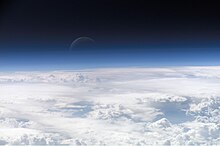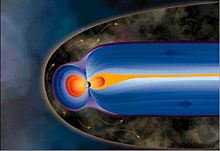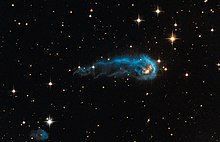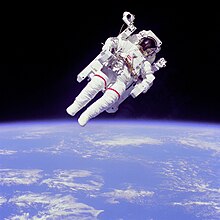space
Outer space denotes the space between celestial bodies . The atmospheres of solid and gaseous celestial bodies (such as stars and planets ) have no fixed upper limit, but gradually thin out with increasing distance from the celestial body. Above a certain height one speaks of the beginning of space.
In space there is a high vacuum with low particle density. However, it is not empty space, but contains gases , cosmic dust and elementary particles ( neutrinos , cosmic rays , particles), as well as electric and magnetic fields , gravitational fields and electromagnetic waves ( photons ). The almost complete vacuum in space makes it extremely transparent and allows the observation of extremely distant objects, such as other galaxies . However, fog can come offinterstellar matter also severely impede the view of objects behind it.
The concept of space is not to be equated with the universe , which is a Germanized term for the universe as a whole and thus includes everything , including the stars and planets themselves. Nevertheless, the German word "Weltall" or "All" is used colloquially with the meaning "space".
The exploration of space is called space exploration . Travel or transport in or through space is referred to as space travel .
Transition to space

The transition between the earth's atmosphere and space is fluid. The Fédération Aéronautique Internationale (FAI) defines the limit to space at 100 kilometers (62 mi ) above sea level , the Kármán line . At this altitude, the speed needed to gain lift to fly is equal to the orbital speed of a satellite , so above this line one can no longer meaningfully speak of aviation . Deviating from this, the US NASA and the US Air Force already define the height of 50 miles (approx. 80 km) as the beginning of space. Both heights proposed as limits are in the upper atmosphere . There is no internationally binding height limit to space.
Another height definition that is being discussed is the lowest possible perigee height of an earth satellite, since the thin atmosphere still has a not inconsiderable braking effect above 100 kilometers. For an elliptically orbiting spacecraft with propulsion, the lowest possible perigee height is about 130 kilometers. For a spacecraft without propulsion, it is about 150 kilometers. But even at 400 kilometers, the flight altitude of the International Space Station , a braking effect of the atmosphere can still be felt, as a result of which the ISS constantly loses altitude and has to be repeatedly pushed back to a higher orbit by docked spaceships.
The Karman line of Venus is at about 250 kilometers altitude, that of Mars at about 80 kilometers. For celestial bodies that have little or no atmosphere, such as Mercury , Earth's moon , or asteroids , space begins right at the body's surface.
When spacecraft re- enter the atmosphere, a re-entry altitude is set for the calculation of the trajectory such that the influence of the atmosphere is practically negligible up to the point of re-entry; from this point it must be taken into account. Usually, the re-entry altitude is equal to or higher than the Karman line. NASA uses the value of 400,000 feet (approx. 122 kilometers) for the earth as the re-entry altitude.
areas

There are major differences in space between near-Earth space, interplanetary space , interstellar space , intergalactic space , and the voids .
Near-Earth Space
Near- Earth space, also known as geospace , is dominated by the earth's magnetic field (and not the sun's magnetic field ). It extends from the upper regions of the atmosphere to the edge of the Earth's magnetosphere . This measures about ten earth radii (about 60,000 km) on the sunny side, and about one hundred earth radii (600,000 km) on the night side in the form of a long tail. The terrestrial magnetosphere deflects the solar wind flowing away from the sun around the earth and thus protects it from most of the particle stream that is dangerous for living beings. Only a small part of the solar wind enters the earth's atmosphere near the poles and is visible there as auroras .
Changes in the interplanetary medium in near-Earth space are referred to as space weather . Main causes are changes in the solar wind and the cosmic rays of the Milky Way . Due to these influences, increased matter, particle and radiation streams enter the environment of the earth at irregular intervals.
Not all celestial bodies have such magnetic fields. For example, the moon is exposed to the solar wind without protection.
The inner region of the Earth's magnetosphere is the toroidal plasmasphere filled with relatively cool plasma (shown in red in the adjacent graphic). There is also a toroidal radiation belt in the Earth's magnetosphere , the Van Allen belt . Hard ionizing radiation prevails in this part of near-Earth space .
interplanetary space


Interplanetary space is the space in our solar system filled with interplanetary dust , solar wind and the sun's magnetic field . The sun's magnetic field interacts with the solar wind and largely determines its flow. Conversely, the solar wind, as an electrically conductive plasma , also conducts and strengthens the sun's magnetic field.
Interplanetary space is the space within the heliosphere up to the boundary layer of the heliopause . The heliosphere has an estimated radius of about 110 to 150 AU and in turn protects the solar system and planets from very energetic cosmic ray particles.
interstellar space


Interstellar space is the space between the astropauses of stars within a galaxy . It is filled with interstellar matter and the galactic magnetic field. Interstellar matter plays an important role in astrophysics , since it gives rise to stars that, with stellar winds and supernovae , also release matter back into interstellar space.
There are regions of higher particle density in interstellar space called interstellar clouds . A distinction is made between different types of such clouds according to their density, size and temperature: in HI regions , the hydrogen is present in neutral atomic form, in H-II regions it is ionized in atomic form (a plasma state of individual protons), and in molecular clouds as molecular hydrogen (H 2 ). New star systems are formed from molecular clouds by gravitational contraction. Our solar system also emerged from such a cloud, the primordial cloud .
The matter density in the interstellar medium can vary greatly. On average it is about 10 6 particles per cubic meter, but in cold molecular clouds it can be 10 8 to 10 12 particles per cubic meter. Giant molecular clouds can be millions of times the mass of the Sun and account for a significant fraction of the mass in the interstellar medium.
At the boundaries of the astropauses, if the speed of the star relative to the interstellar medium is large enough, shock fronts ( bow shocks ) can occur. In the case of the sun, the speed is probably too low for this, so that instead of a bow shock wave , only a relatively gentle bow wave is assumed.
On September 12, 2013, NASA announced that the Voyager 1 spacecraft left the heliosphere on August 25, 2012 when it registered a sudden increase in plasma density. Voyager 1 was the first man-made object to reach interstellar space. The sister probe Voyager 2 left the heliosphere as the second object on November 5, 2018.
The Sun has been transiting the Local Flake , a region in interstellar space denser than its surroundings, for about 100,000 years and is expected to exit again in 10,000 to 20,000 years. The Local Flake resides within the Local Bubble , a lower-density region of the Milky Way .
intergalactic space

Intergalactic space is the space between galaxies. Most of the universe is intergalactic space. The intergalactic medium consists mainly of ionized hydrogen gas/plasma (HII), i.e. equal amounts of free protons and electrons.
The intergalactic medium between the galaxies is not uniformly distributed, but exists in thread-like connections called filaments . Galaxy clusters and superclusters are located at their nodes . Between the filaments there are huge empty spaces with a much lower matter density, called voids . The voids contain only a few galaxies. The filaments and voids are the largest known structures in the Universe.
The intergalactic medium is divided into two types. The gas that flows out of the voids into the area of the filaments heats up to temperatures of 10 5 K to 10 7 K. This is hot enough that when atoms collide, the electrons separate from the hydrogen nuclei, which is why it exists as an ionized plasma. This is called the Warm-Hot Intergalactic Medium (WHIM). (Although the plasma is very hot by Earth standards, 10 5 K is often referred to as "warm" in astrophysics.) Computer simulations and observations suggest that up to half of all atomic mass in the universe exists in this dilute, warm-hot plasma state .
Where gas flows from the filament structures of the WHIM into the nodal points of the cosmic filaments, it heats up even further, reaching temperatures of 10 7 K to 10 8 K, sometimes even higher. This intergalactic medium is called the intracluster medium (ICM). It can be observed by its strong emission of X-rays .
temperature of space
No temperature can be assigned to the room itself , but only to its matter and the radiations acting in it . The (very sparsely distributed) matter in space can have very high temperatures. The earth's high atmosphere reaches temperatures of around 1400 Kelvin . The intergalactic plasma, with a density of less than one hydrogen atom per cubic meter, can reach temperatures of several million Kelvin; in a galaxy cluster like the Perseus cluster also 100 million Kelvin. The high temperature results from the high speed of the particles. It shows up, for example, in a strong X-ray emission that emanates from such hot intergalactic plasma. However, an ordinary thermometer would show temperatures close to absolute zero , since the particle density is far too low to cause any measurable heat transfer. So, in a sense, it's "extremely hot" and "extremely cold" at the same time in space.
The microwave background radiation measured in all directions is 2.725 Kelvin (−270.425 °C) and is the theoretical equilibrium temperature of matter when it does not generate its own thermal radiation through energy conversion . But because of the Joule-Thomson effect , there are also colder regions. The boomerang fog has the coldest natural temperature at minus 272 degrees Celsius – just one degree above absolute zero.
Solid bodies in near-Earth or interplanetary space experience great radiant heat on their side facing the sun, but great cold on their side facing away from the sun, because that is where they radiate their heat energy into space. For example, the surface of the moon on the sun-facing side gets hot up to 130 °C, on the side facing away from the sun it drops to about −160 °C. Likewise, for example, the space suit of an astronaut who undertakes a spacewalk at the International Space Station will heat up to about 100 °C on the side facing the sun. On the night side of the Earth, the Sun's radiation is blocked, and the Earth's weak infrared radiation cools the space suit to about −100 °C.
space and weightlessness
Contrary to popular belief, space is by no means universally weightless . The gravitational force of the mutual attraction of masses acts everywhere and over the longest distances. Weightlessness always occurs in space when a body experiences only gravitational acceleration, so that it is in free fall . Optionally, the free fall guides the body on an orbit around a celestial body.
Whenever a spacecraft accelerates or brakes of its own accord, it is no longer in free fall and an acceleration force ( g-force ) can be felt. A rotating body also experiences a centrifugal force proportional to its size and speed of rotation . Both forces are caused by the inertia of the body.
Whenever a body is hampered in its fall, it experiences heaviness from an opposing force . For a planet or moon without an atmosphere (such as Earth's moon ), space extends to the ground. All objects on the surface of the celestial body are therefore also in space at the same time. Since their fall is restrained by the ground, they do not experience weightlessness, but the normal gravity of the celestial body.
Man in space
- See also space liability , space colonization , space tourism , space troops , space weapon , space age
space travel

The history of space travel begins with the development of the rocket and rocketry , particularly rocket engines . See list of launch vehicle launch lists .
Unmanned Spaceflight
The first man-made objects to break through the boundary to space were ballistic artillery rocket weapons of the type Aggregat 4 (“A4” for short), which were developed by the German Reich under the direction of Wernher von Braun during World War II and used in military operations from 1942 became. In 1944, Nazi propaganda dubbed this rocket model " Vergeltungswaffe 2", or "V2" for short.
With Operation Overcast and subsequent programs, leading German rocket engineers, including Wernher von Braun, were relocated to the United States after World War II. The US space developments began with the captured technology of the A4 and the German engineers.
Soviet space travel also began with the German A4 rocket, which came to the Soviet Union as spoils of war after 1945, accompanied by a number of rocket engineers. Under Sergei Pavlovich Korolyov , the A4 was first built, then the world's first ICBM and carrier rocket R-7 was developed from 1950 and used from 1953. The first artificial earth satellite , Sputnik 1 , was also launched in 1957 with an R-7 . This made it clear that the Soviet Union was at least technologically equal to the USA in the development of its space flight (“ Sputnik shock ”).
In unmanned space flight, the spacecraft used include launch vehicles, artificial satellites , space probes and space telescopes .
Manned spaceflight
Manned spaceflight began in the Cold War era during the “ space race ” between the warring superpowers USA and the Soviet Union . The first man in space was Soviet cosmonaut Yuri Gagarin on April 12, 1961 . The first US astronaut in space a few weeks later on May 5, 1961 was Alan Shepard ; the first (and for a long time the only) woman in space was Valentina Vladimirovna Tereshkova in 1963 . In 1965, Alexei Leonov became the first person to leave his spaceship in a spacesuit and float freely in space on a spacewalk. The first German 1978 Sigmund Jähn ; the first Austrian in 1991 Franz Viehböck , and the first (and so far only) Swiss in 1992 Claude Nicollier .
Under the direction of Wernher von Braun, the family of Saturn rockets was developed for the civil US federal agency NASA as part of the US Apollo program . These powerful launch vehicles, which began operations in 1961 and ended in 1975, were the first and only time that humans were carried beyond low Earth orbit. A total of 24 astronauts were flown to the moon on Saturn rockets, 12 of whom walked on the lunar surface. The Soviet manned lunar program was halted after 4 false launches of the large N1 rocket without a cosmonaut setting foot on the moon.
Launchers, spaceships, space shuttles , space planes and space stations are used in manned space flight.
space law
The area of law related to national and international activities in space is called space law.
The Outer Space Treaty adopted by the United Nations in 1967 ( Treaty on Principles Governing the Activities of States in the Exploration and Use of Outer Space, including the Moon and Other Celestial Bodies ) is the fundamental treaty of space law.
exploration of raw materials

It is assumed that raw materials such as rocks , precious metals or rare earths can be found on or in celestial bodies in large quantities and with great economic value. Near- Earth asteroids , for example, consist of 30% metals such as iron and nickel , as well as smaller amounts of cobalt , gold or platinum .
Mining in space is still nothing more than a collective term for corresponding future visions and concepts.
In 2014, ESA researchers presented ideas for developing the moon economically at the ESOF science conference in Copenhagen .
In 2015, the USA passed a law allowing its citizens to use rocks in space for commercial purposes. The US company Deep Space Industries (DSI), which wants to develop this potential sector, drew parallels in 2016 with historical land grabs in the Wild West and the California Gold Rush in the 19th century to attract investors.
In November 2016, the small EU state of Luxembourg presented a draft law on the promotion of raw materials in space, which is intended to give researchers and investors legal certainty about any ownership of material from space. The Space Resources initiative founded by Luxembourg aims to extract raw materials such as metals and minerals , but also water from celestial bodies close to Earth. These are to be used primarily in space for space travel and enable a new space industry : hydrogen and oxygen could be used as fuel for spacecraft or astronauts could be supplied with water found on asteroids. US companies such as DSI and Planetary Resources (PR) have already established European branches in Luxembourg. Luxembourg's government itself is initially funding "space mining" with 200 million euros.
See also
itemizations
- ↑ Layers of the Atmosphere . National Weather Service webpage , January 5, 2010. Retrieved November 3, 2010.
- ↑ 100 km Altitude Boundary for Astronautics ( memento of August 22, 2011 on WebCite ) in: fai.org astronautics
- ↑ Space Environment and Orbital Mechanics . United States Army. Retrieved April 24, 2012.
- ↑ Where does space begin? In: scienceblogs.de. Astrodicticum Simplex, March 2, 2015, retrieved May 23, 2016 .
- ↑ Space Environment. Isidoro Martínez, retrieved May 23, 2016 .
- ↑ Hubble sees a cosmic caterpillar . In: Image Archives . ESA/Hubble. Retrieved September 9, 2013.
- ↑ GP Zank, et al. – HELIOSPHERIC STRUCTURE: THE BOW WAVE AND THE HYDROGEN WALL (2013)
- ↑ NASA Spacecraft Embarks on Historic Journey Into Interstellar Space (accessed September 2013)
- ↑ Sean Potter: NASA's Voyager 2 Probe Enters Interstellar Space. In: NASA.gov . December 10, 2018. Retrieved December 10, 2018 (English).
- ↑ How cold is space? , retrieved September 22, 2015
- ↑ Robert Gendler: A Year in the Life of the Universe: A Seasonal Guide to Viewing the Cosmos . Voyageur Press, 2006, ISBN 978-0-7603-2642-8 , pp. 47 ( books.google.de ).
- ↑ Why is it so cold in the coldest place in space? @ spectrum.de, March 30, 2014, The Coldest Place in the Universe National Radio Astronomy Observatory, accessed November 8, 2018
- ↑ How warm is it in space? , retrieved September 22, 2015
- ↑ a b c badische-zeitung.de , Economy , November 12, 2016, Birgit Reichert: Luxembourg wants to dig for treasures in space - the government is presenting a law on space mining.
- ↑ deutschlandfunk.de , Background , October 15, 2016, Jan Bösche: Wild West of the Future (November 12, 2016)
- ↑ deutschlandfunk.de , current research , June 25, 2014, Frank Grotelüschen: The moon as a raw material mine (November 12, 2016)
- ↑ deutschlandfunk.de , Background , October 15, 2016, Jan Bösche: Wild West of the Future (November 12, 2016)

